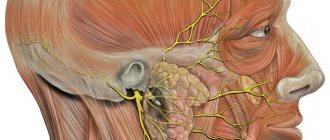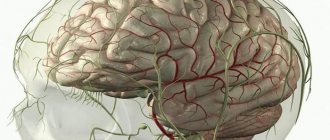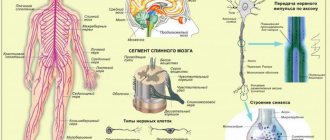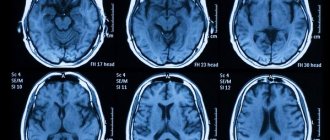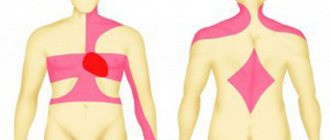symptoms of cranial nerve damage
Category: Neurological Nursing/Clinical manifestations of major neurological syndromesOlfactory nerves
.
In pathological processes, a decrease (hyposmia) or loss (anosmia) of the sense of smell occurs
; less often, sensitivity to odors increases (hypersmia), the sense of smell is distorted (dysosmia), and olfactory hallucinations occur.
Optic nerves
.
Visual disorders are manifested by changes in visual acuity, color perception and visual fields.
Most often, there is a decrease in visual acuity (amblyopia) or complete blindness (amaurosis), concentric narrowing of the visual fields, loss of half of the visual fields (hemianopia), or their segments (scotoma) .
When the cortical centers of vision (occipital lobes) are damaged, visual agnosia, visual hallucinations, and photo-metamorphopsia (flashes of light, distorted contours of objects) appear. Color vision disorders are observed in the form of achromatopsia (inability to distinguish colors) and color blindness (blindness to green or red). When examining the fundus, swelling of the optic disc, its atrophy, and changes in retinal vessels can be detected, which is important for diagnosing cerebral pathology
.
Oculomotor nerves
.
Damage to the oculomotor nerve (III pair) appears with drooping of the upper eyelid (ptosis), dilation of the pupil (mydriasis), divergent strabismus and double vision (diplopia)
. Pathology of the trochlear nerve (IV pair) is characterized by double vision when looking down. When the abducens nerve is disturbed, convergent strabismus and diplopia are found.
Trigeminal nerve
.
In case of damage to the motor nuclei and fibers of the trigeminal nerve, paresis of the masticatory muscles is observed
. Sensitivity disorders depend on the localization of the process. When the branches of the nerve are damaged, all types of sensitivity in the area of their innervation are impaired. Damage to the trigeminal nerve ganglion is manifested by pain and sensitivity disorders in the area of innervation of all branches of the nerve. Damage to the nerve nuclei is accompanied by impaired pain and temperature sensitivity on the face in the form of concentric zones.
Facial nerve
.
The pathology is manifested by paralysis of the facial muscles on the affected side
.
vestibulocochlear nerve
.
When it is damaged, hearing decreases (hypacusia) up to deafness (anacusia), sometimes hearing worsens (hyperacusis)
. Irritation of the hearing aid causes sensations of noise, crackling, whistling, buzzing in the ears and head; auditory hallucinations are possible. Violation of the vestibular apparatus is accompanied by systemic dizziness, nystagmus, nausea, vomiting, aggravated by head movements. This symptom complex is called vestibular syndrome, or vestibular ataxia.
Glossopharyngeal and vagus nerves (IX-X)
.
Their defeat is accompanied by impaired swallowing (dysphagia), a nasal voice (dysphonia), and the absence of pharyngeal and palatal reflexes
. This symptom complex is called “bulbar syndrome”.
Hypoglossal nerve
. Its damage causes atrophy and deviation of the tongue.
Accessory nerve
—
suffers rarely; with bilateral damage, a “dangling head” is observed, the inability to raise the shoulders
.
See clinical manifestations of major neurological syndromes
Saenko I. A.
Sources:
- Bortnikova S. M., Zubakhina T. V. Nervous and mental illnesses. Series 'Medicine for you'. Rostov n/d: Phoenix, 2000.
- Nurse's Handbook for Care/N. I. Belova, B. A. Berenbein, D. A. Velikoretsky and others; Ed. N. R. Paleeva. - M.: Medicine, 1989.
- Martynov Yu. S. Neurology: Textbook. ed. 4th, rev. and additional - M.: RUDN, 2009.
Possible diseases and pathologies
Damage to the cranial nerves causes serious abnormalities in the functioning of the body. Diagnosis of disorders of the cranial nerve is carried out through a neurological examination.
Anosmia
Complete or partial loss of smell. Patients with anosmia cannot perceive all or certain odors. Loss of smell can also occur due to age.
Impaired perception of smell does not allow one to fully taste the taste of food and emotionally suppresses the patient.
Classification
There are congenital and acquired anosmia. Acquired anosmia may occur due to damage to the olfactory nerve. A congenital disease occurs due to pathologies at birth: a defect of the nasopharynx, mucous membrane. Cranial nerves whose anatomy is defective may also have congenital anosmia.
Symptoms and signs
The main symptom of anosmia is loss of smell perception. Patients who notice this symptom should contact an ENT doctor. He prescribes appropriate diagnostics to identify the causes of the disease. Anosmia is often diagnosed using olfactometry, a test in which a person needs to recognize odorous substances presented by a specialist.
Causes
Reasons include:
- Diseases of the nasopharyngeal mucosa (colds, rhinitis).
- Traumatic brain injury.
- Smoking.
- Parkinson's disease.
- Alzheimer's disease.
- COVID-19.
- Nasal polyp.
Treatment methods
If, after examination by a specialist, it turns out that the cause is inflammation of the mucous membrane, then the following treatment methods are suitable. Camomile tea.
Recipe:
- 1 tsp Steam chamomile leaves with a glass of boiling water.
- Leave the decoction for 15 minutes. until partially cooled. The infusion should be warm while straining.
Application: you need to rinse the nasal cavity 2 times a day for 5-10 days. You need to draw in the liquid through your nostrils and, as you exhale, remove it through your nose or mouth. Collection of herbs.
Recipe:
- 30 g dried sage flowers, calendula;
- 20 g of dried herb St. John's wort, plantain;
- 10 g horsetail, spring primrose.
- Mix ingredients, 1 tbsp. spoon 1 cup boiling water.
- Cook the mixture for 1 minute.
- Leave for 30-40 minutes and strain.
Application: fill a spray bottle with the decoction, insert into the nose and irrigate 2 times a day for 10 days. Saline solutions: Aquamaris, physiomer and aqualor help cope with anosmia. Use according to the instructions for the drug. Use for 5-10 days. Aloe leaf drops.
Another effective remedy is aloe drops:
- Keep 1-3 aloe leaves in the refrigerator for 2 weeks.
- Squeeze out the juice, dilute with cold boiled water in a ratio of 1 to 10.
Application: drop into the nose up to 4 times a day, 4-6 drops in each nostril. The course lasts 5-10 days.
Bell's palsy
Cranial nerves whose anatomy is damaged can cause nerve palsy. Bell's palsy is a common form of facial nerve defect. Every year new clinical manifestations of this disease are identified. The incidence is approximately 23 people per 100,000 each year.
Bell's palsy has nothing in common with stroke, but the two can be confused because the clinical manifestations are similar in some ways. Both in the case of a stroke and in the case of paralysis, prompt medical attention and long-term treatment are necessary. Modern medicine is able to fight Bell's palsy and quickly remove the consequences of the disease.
Classification
The paralysis may extend to one side of the face or, in rare cases, to both.
There are 6 degrees of severity of the disease:
- No pathology . The muscles are normal.
- Presence of minor irregularities . At this stage, when moving, there is a noticeable asymmetry between the left and right sides of the face.
- Moderate pathology . Asymmetry is also observed in calm. The affected eyebrow and corner of the mouth are lowered, the eyes are completely closed.
- Average severity of pathology . The face is distorted, there is no symmetry. The eyelids do not droop completely, the forehead muscles are immobilized.
- Severe pathology . Facial muscles do not contract. At rest, the left and right sides are asymmetrical.
- Complete paralysis . At maximum effort, the muscles affected by paralysis do not contract. The face is skewed, not asymmetrical.
Symptoms and signs (external signs, how it manifests itself)
Paralysis appears suddenly. Symptoms include severe weakness and pain near the ear. Some patients lose their perception of the taste of foods. Paralysis is cured in 80% of patients in 1-2 weeks or months.
Early symptoms include a slight increase in temperature and stiffness on one side of the face.
Causes
Paralysis can occur due to a number of reasons. It includes both infectious diseases and injuries. Bell's palsy is often the result of inflammation of the facial nerve.
The causes of the disease include the following:
- Hypothermia.
- Colds.
- In a certain season.
- Flu.
- Rubella.
- Diabetes mellitus.
- Tumors of the brain and parotid gland.
- High blood pressure.
- Head and facial nerve injuries.
Treatment methods
Supportive treatments for Bell's palsy include:
- Acupuncture to relax muscles and relieve pain. It also helps conduct nerve impulses along the facial nerve.
- Gymnastics. Method of prevention and rehabilitation. Facial gymnastics includes smiling with the mouth closed, squinting, closing and opening the eyes, and raising the eyebrows.
- Traditional methods of prevention are treatment with mud or paraffin compresses. Their temperature should be from 40 to 500 degrees, depending on the type of compress.
- Clinically, paralysis is treated with Furosemide 40 mg per day.
- Alpha lipoic acid is prescribed. Recommended dose: 600 mg per day.
- Ipidacrine. Improves the conductivity of nerve impulses. Use 20 mg 3 times a day.
Strabismus
This is a disease that may be caused by a pathology of the abducens nerve. Strabismus manifests itself in the deviation of the eyeball from the object in question. The eyes cannot be directed to one point.
Classification
There are acquired and congenital, horizontal and vertical strabismus.
Horizontally converging (to one point) or diverging (the eye is directed to the other side) strabismus is more often diagnosed:
- Monocular strabismus involves abduction of one eye, while alternating strabismus involves abduction of both eyes.
- Alternating strabismus differs from monocular strabismus in that a person looks at an object alternately. Moreover, both eyes are used.
Symptoms and signs
Symptoms of strabismus include:
- Deviation of the eye to the side.
- "Floating" look.
- Limited eye mobility.
- Lack of symmetry of gaze.
- Dizziness.
- Head deviation.
Causes
The causes of strabismus can be congenital or acquired.
The examination may reveal the following causes of the disease:
- Injuries.
- Paralysis.
- Congenital pathologies.
- Prolonged stress.
- Flu, COVID-19, other infectious diseases.
- Mental trauma, for example, severe fear.
- Farsightedness or nearsightedness in a serious degree of development.
Treatment methods
Strabismus is treated with medications, computer programs, and surgery:
- Pleoptic method . Intentional heavy stress on the defective eye. Treatment using special computer technologies.
- Orthoptic method . Special equipment and computer programs are used to restore the symmetry of the gaze.
- Diploptic method . The most gentle. Assumes natural strain on the eye under familiar conditions.
- Modern medicine offers the devices “Sinoptofor” and “Monobinoscope” for the treatment of strabismus. The number of procedures is prescribed individually by ophthalmologists.
- In surgery, strabismus is treated with Botox. It is injected into the oculomotor muscles. Thus, the affected muscle stops pulling the others in its direction and the position of the eye is normalized. Adverse consequences are possible, such as a constant feeling of sand in the eyes. There is dryness and cutting pain when blinking.
When the cranial nerve is damaged, they try to improve its conductivity and correct anatomical defects. This is done through surgical intervention and preventive work with computers.



